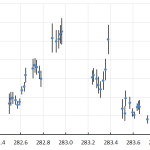Abstract: A summary of the activity of the CAMS BeNeLux network during the month of November 2020 is presented. 17241 multiple station meteors were recorded. In total 5441 orbits were collected during this month, a second-best November month for CAMS BeNeLux.
1 Introduction
November is a typical autumn month with rather unstable weather over the BeNeLux. Completely clear nights are rare during this time of the year. However, during the long nights with 13 to 14 hours dark sky, it is also rare that clouds remain all night present. Very often clear gaps appear during which meteors can be registered. To be successful in a month like November is a matter of having the cameras operational. With most stations running Auto CAMS seven days on seven, still a lot of double station meteors can be registered during periods with unexpected clear sky.
2 November 2020 statistics
CAMS BeNeLux collected 17241 multi-station meteors (9339 in 2019), good for 5441 orbits (3237 in 2019, 6916 in 2018). This is a much better result than in 2019. November 2018 was an exceptional favorable month of November and November 2020 is the second best. AutoCams functioned at 18 camera stations, at 5 stations the cameras were only started when there was a chance for clear skies. Not all the camera stations could participate during the entire month.
This month counted 18 nights with more than 100 orbits (10 in 2019 and16 in 2018). Two nights produced more than 500 orbits in a single night (1 in 2019 and 6 in 2018). The best November night in 2020 was 12–13 with as many as 2240 multi-station meteors, good for 611 orbits in this single night. Only two nights remained without any orbits. The statistics of November 2020 are compared in Figure 1 and Table 1 with the same month in previous years since the start of CAMS BeNeLux in 2012. In 9 years, 207 November nights allowed to obtain orbits with a grand total of 25236 orbits collected during November during all these years together.
While November 2019 had 77 cameras at best and 71.1 on average, November 2020 had 88 cameras at best and 72.6 on average. Since the last major expansion of CAMS BeNeLux in 2017, the number of operational cameras remained stable with a number of new cameras compensating the number of cameras that ceased participation in the CAMS network.

Figure 1 – Comparing November 2020 to previous months of November in the CAMS BeNeLux history. The blue bars represent the number of orbits, the red bars the maximum number of cameras running in a single night and the yellow bar the average number of cameras running per night.
Table 1 – November 2020 compared to previous months of November.
| Year | Nights | Orbits | Stations | Max. Cams | Min. Cams | Mean Cams |
| 2012 | 14 | 165 | 6 | 8 | – | 4.4 |
| 2013 | 13 | 142 | 10 | 26 | – | 9.8 |
| 2014 | 24 | 1123 | 14 | 33 | – | 21.1 |
| 2015 | 23 | 1261 | 15 | 47 | 10 | 29.8 |
| 2016 | 24 | 2769 | 19 | 56 | 19 | 42.2 |
| 2017 | 26 | 4182 | 22 | 88 | 57 | 74.2 |
| 2018 | 28 | 6916 | 21 | 85 | 59 | 75.3 |
| 2019 | 27 | 3237 | 20 | 77 | 60 | 71.1 |
| 2020 | 28 | 5441 | 23 | 88 | 57 | 72.6 |
| Total | 207 | 25236 |
3 Conclusion
November 2020 brought exceptionally favorable autumn weather for the BeNeLux what resulted in a second-best November month during 9 years of CAMS BeNeLux.
Acknowledgment
Many thanks to all participants in the CAMS BeNeLux network for their dedicated efforts. This report is based on the data from the CAMS-website with thanks to Martin Breukers for providing the information for the camera stations.
The CAMS BeNeLux team was operated by the following volunteers during the month of November 2020: Hans Betlem (Leiden, Netherlands, CAMS 371, 372 and 373), Felix Bettonvil (Utrecht, Netherlands, CAMS 376 and 377), Jean-Marie Biets (Wilderen, Belgium, CAMS 379, 380, 381 and 382), Martin Breukers (Hengelo, Netherlands, CAMS 320, 321, 322, 323, 324, 325, 326 and 327, RMS 328 and 329), Guiseppe Canonaco (Genk, RMS 3815), Bart Dessoy (Zoersel, Belgium, CAMS 397, 398, 804, 805), Jean-Paul Dumoulin, Dominique Guiot and Christian Walin (Grapfontaine, Belgium, CAMS 814 and 815, RMS 003814), Uwe Glässner (Langenfeld, Germany, RMS 3800), Luc Gobin (Mechelen, Belgium, CAMS 3890, 3891, 3892 and 3893), Tioga Gulon (Nancy, France, CAMS 3900 and 3901), Robert Haas (Alphen aan de Rijn, Netherlands, CAMS 3160, 3161, 3162, 3163, 3164, 3165, 3166 and 3167), Robert Haas (Texel, Netherlands, CAMS 810, 811, 812 and 813), Robert Haas / Edwin van Dijk (Burlage, Germany, CAMS 801, 802, 821 and 822), Kees Habraken (Kattendijke, Netherlands, RMS 000378), Klaas Jobse (Oostkapelle, Netherlands, CAMS 3030, 3031, 3032, 3033, 3034, 3035, 3036 and 3037), Carl Johannink (Gronau, Germany, CAMS 311, 314, 317, 318, 3000, 3001, 3002, 3003, 3004 and 3005), Hervé Lamy (Dourbes, Belgium, CAMS 394 and 395), Hervé Lamy (Humain Belgium, CAMS 816), Hervé Lamy (Ukkel, Belgium, CAMS 393), Koen Miskotte (Ermelo, Netherlands, CAMS 351, 352, 353 and 354), Steve Rau (Zillebeke, Belgium, CAMS 3850 and 3852), Paul and Adriana Roggemans (Mechelen, Belgium, CAMS 383, 384, 388, 389, 399 and 809, RMS 003830 and 003831), Hans Schremmer (Niederkruechten, Germany, CAMS 803) and Erwin van Ballegoij (Heesch, Netherlands, CAMS 347 and 348).




